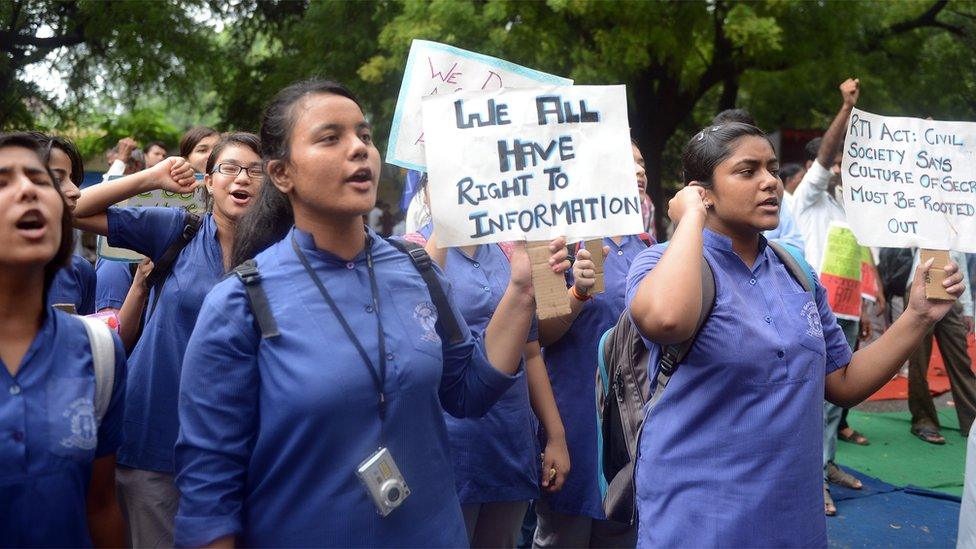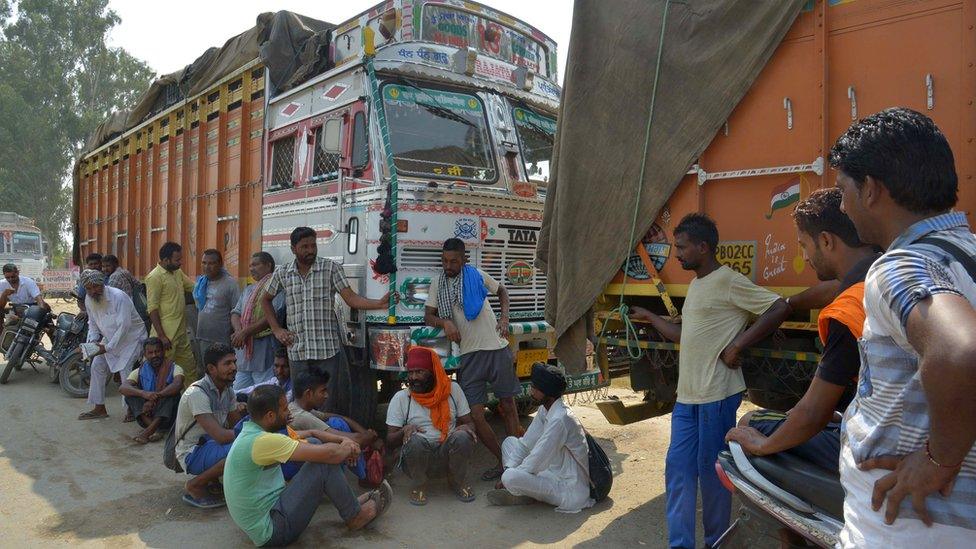How the right to information law is changing India
- Published

RTI 'laga denge!' (we will file an RTI application) is a popular refrain of the frustrated Indian who comes face to face with arbitrary power
India marks 10 years since the introduction of a landmark law that allows people to access information held by the government. Social activists Aruna Roy and Nikhil Dey explain how the law has deepened democracy in the country.
Ten years ago, on 12 October 2005, the Right to Information (RTI) law came into effect in India.
The law has been India's most powerful "weapon of the weak" enabling citizens everywhere to question and hold to account the legislature, executive and judiciary. It has helped expose misdeeds and corruption by governments.
The use of this law has underscored the citizens' right to make informed choices and deepen Indian democracy. It has enabled the ordinary person to exercise sovereignty not merely in the casting of a vote every five years, but by questioning arbitrary power every day.
RTI 'laga denge!' (we will file an RTI application) is a popular refrain of the frustrated Indian who comes face to face with arbitrary power.
An estimated five to eight million RTI applications are filed every year, demonstrating the popularity of the law.
That more than 45 RTI users have been killed, bears testimony to how transparency threatens vested interests.
But the law faces difficult times ahead.
The challenges to RTI
Both past and present governments have tried to dilute the law, either through amendments or through delays and manipulations in the appointment of information commissioners.
Most recently, the ruling Narendra Modi-led BJP government left the vital post of the Central Information Commissioner, external vacant for eight months.
All political parties have together shown disrespect for the rule of law, by ignoring orders of the information commission mandating their inclusion under the RTI.
And a few instances of obvious 'misuse' of the RTI by blackmailers and eccentrics, have been blown out of proportion in an attempt to discredit the law.

In a case on the disclosure of assets of judges, the Supreme Court has gone in appeal to itself
Commissions are becoming bogged down in years of delay, like the courts of India. The courts have also shown how reluctant they are to part with information about their own functioning.
In a case on the disclosure of assets of judges for instance, the Supreme Court has gone in appeal to itself.
It is important to understand the immense contribution of ordinary Indians, who battled for years, to get this entitlement. The demand for information was brilliant in its simplicity.
In the early 1990s, peasants and workers in central Rajasthan focused on demands for details of government spending on roads, life saving medicines in hospitals, and disappearing rations. This sent shock waves through the establishment.
The RTI has since proved its efficacy from the village council to the parliament.
Cutting through red tape and bureaucratic prevarication, it has exposed entrenched vested interests in policy and implementation, and undermined the impunity with which both grand corruption and mass corruption are perpetrated.
Era of transparency
The RTI movement built an effective, and popular discourse using slogans and songs to articulate and communicate. The law was seen and used as a transformational right.
The enactment of RTI not only inspired a spate of other rights based laws, but also embedded transparency and accountability to the people within them.

The RTI has proved its efficacy from the village council to the parliament
And despite all the problems with implementation, the era of transparency is here to stay.
The battles are now for accountability: passage and proper implementation of laws relating to grievances of citizens, external, protection of whistle blower, externals, and appointment of anti-corruption ombudsmen, external.
Much eventually depends on an alert and vocal people.
The encouraging sign over the last decade is that the Indian citizen is vigilant, proactive, and peaking out.
Their voice must be strengthened and amplified, as it is our primary hope for building a truly participatory democracy.
- Published18 March 2011